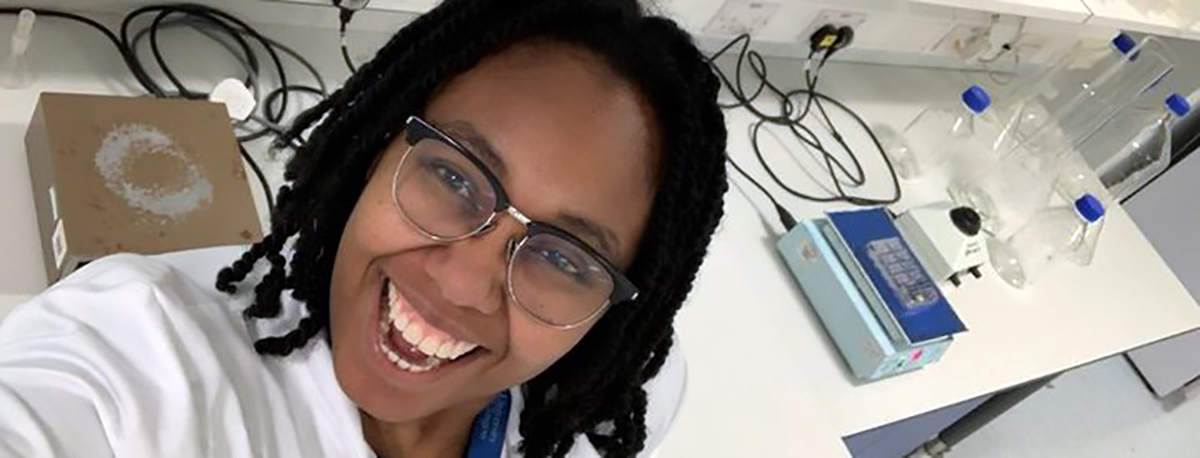Being a scientist versus being a black woman who studies science

by Trecia, from Jamaica, studying Biomedical Sciences (PhD)
The reality
At an early age, my thoughts of a scientist immediately captured a male decked out in a white coat, and yes the man was white. Far be it from me to think that a scientist could be black, and a woman at that. However, as a black woman who is a medical doctor by training, I thought that assimilating into the cultural hub of my current postgraduate environ would be so easy; because for years I had punctuated my dreams with thoughts of working in a predominantly Caucasian laboratory. To be fair, what did I have to complain about, I was lucky to get an opportunity to work in a first-world country, such as the United Kingdom, so why make a fuss about not seeing any one of my skin colour? It was not until my first day at the Queen’s Medical Research Institute (QMRI), “bright-eyed and bushy-tailed” might I add, when I realized that my thoughts/dreams were not the same as my current reality. As I walked along the corridors, I felt entombed by the constant images of predominantly old Caucasian male scientists. I was teleported to the past, and I was not coping; I was back in the old Victorian era when only white male scientists were permitted to practice science/medicine. Over the ensuing 6-months of my PhD, I felt like an imposter, and lacked a deep sense of belonging, a true sense of purpose: the so-called raison d’etre.
The change
My change wasn’t instantaneous, it was gradual. I had to truly understand what it meant to be a scientist, and that definition was not consolidated by one’s race, culture, or creed. A scientist simply gains and shares knowledge for the greater good: humanity, the flora, the fauna, and the universe. I had to make peace in knowing that in some small way I added some richness and diversity to my research. I was a public speaker, a medical doctor, a science communicator, a HIV peer educator, a writer, and a mentor. These skillsets were far more important than just relating to others on a more superficial level: merely just sharing another’s skin colour. Alas, I started to smile more and more throughout the remainder of the first year of my PhD, where I realized rather than fitting in, I was meant to stand out. Finally, I realized that I didn’t stand out because of the “blackness” of my skin; I stood out because of my zeal, thirst for knowledge and intellectual curiosity. I knew in that moment I wanted to cure kidney diseases, and I would use every encounter with researchers in the Centre for Cardiovascular Science (CVS) to do so. The impetus was not to blend in with the masses; I was going to forge my scientific craft by using their astute minds as my proverbial trampoline. I aimed to learn as much as I could from both students, lab technicians, junior and senior scientists, and professors, so that I could make a difference in the lives of those who suffered most: patients with chronic kidney disease.
My inspiration for the future
At the time of joining the CVS laboratory, I was the second black person, and the only black female scientist in the entire department. However, I wasn’t that odd piece to the puzzle. I didn’t slot into the space because of my ethnicity; I was the exact fit because of my academic achievements. I was in the right academic setting, but socially, I was still very unhappy; because I overtly rejected the food served in the nearby cafeteria and shops, and also did not enjoy what was dubbed as postgraduate socials/mixers. So how did I remedy my failing social life? The answers were not clear to me at the time, but for one year, I spent all my free time either going on long walks or watching Netflix in my room. It was not until last year (2023), when I met a Nigerian black female scientist, who as fortuity would have it, was finishing up her master’s in biomedical science. We immediately clicked! She was a Christian: I was a Christian! She loved “soul food;” I loved “soul food!” It was kismet! She came to me for advice, and for the next couple of weeks I helped her prepare for PhD interviews, and spent almost 1hour convincing her to apply for the funding which sponsors my PhD program. The long and short of the story is she got the PhD studentship, and is now completing the first year of her PhD. Cumulatively, if I think of all the racial and cultural changes that have taken place in QMRI since I joined the CVS lab, I will draw a blank. However, if I think of the singular impact that just having one more black person on the third floor makes to the ethos of social integration at the QMRI brings, in a predominantly white space, I would say I feel a greater sense of peace in knowing that this place, and Edinburgh at large, now feels like my “home-away-from-home”! Whilst, the walls of the third floor remain littered by faces of mostly Caucasian male scientists, I will say that I no longer feel disheartened or saddened by those images, because I have come a far way since then, and especially as it relates to science and its progress, those murals do not “speak a thousand words”; or foreshadow the legacy I, or any budding scientist, despite the colour of their skin, will engrave in science.
Want to find out more?



